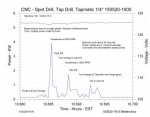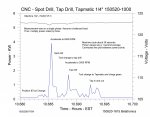gar
Senior Member
- Location
- Ann Arbor, Michigan
- Occupation
- EE
150625-1923 EDT
Attached is a power plot of one cycle of a HAAS VF3 CNC machine drilling and tapping a 1/4-20 hole.
The measurement was made with a TED 1000 System. The primary supply is an open delta wild leg source with one phase being 240-0-240. This is the phase the TED 1000 was connected to. The power axis is scaled for the single phase measured. Assuming the three phases are approximately balanced, then total power is 3 times the single axis value. Note: that by powering the TED from 120 of the source that the voltage is properly phased with respect to the load currents. If the source was a wye, then a 240 to 120 transformer would be required to power the TED MTU.
The residual standby power required is about 3 * 120 W with the servos on. This power is seen as the left most and right most straight lines.
The power measurments are the average power over a 1 second period. One second = 0.000,278 hours. The x-axis is calibrated in hours. From 10.685 to 10.690 is 18 seconds. This is a connected line graph. The one second average power values mostly occur where you see a change in direction of thre curve.
The energy to accelerate the spindle to 6000 RPM is 12 kW for 1/3600 hour or 0.0033 kWh and cost about $ 0.000,5. The cost to drill the tap hole was about (0.6*3)*(4/3600)*0.16 = $ 0.000,32 .
If we assume the machine value is $100 / hr, and machine time is 41 seconds (41 is a better value than the 36 in the plot comment), then the price for the hole is a $ 1.14, and that does not include load and unload time. If many of the same size tapped holes were processed without tool changes, then the cost would be much lower per hole. No matter what, the electric cost is relatively insignificant compared to the machine cost. But this does not mean that reducing electric cost is not worthwhile.
If this was a heavy cutting operation that was removing a lot of metal, then electric costs would be much greater.

.
Attached is a power plot of one cycle of a HAAS VF3 CNC machine drilling and tapping a 1/4-20 hole.
The measurement was made with a TED 1000 System. The primary supply is an open delta wild leg source with one phase being 240-0-240. This is the phase the TED 1000 was connected to. The power axis is scaled for the single phase measured. Assuming the three phases are approximately balanced, then total power is 3 times the single axis value. Note: that by powering the TED from 120 of the source that the voltage is properly phased with respect to the load currents. If the source was a wye, then a 240 to 120 transformer would be required to power the TED MTU.
The residual standby power required is about 3 * 120 W with the servos on. This power is seen as the left most and right most straight lines.
The power measurments are the average power over a 1 second period. One second = 0.000,278 hours. The x-axis is calibrated in hours. From 10.685 to 10.690 is 18 seconds. This is a connected line graph. The one second average power values mostly occur where you see a change in direction of thre curve.
The energy to accelerate the spindle to 6000 RPM is 12 kW for 1/3600 hour or 0.0033 kWh and cost about $ 0.000,5. The cost to drill the tap hole was about (0.6*3)*(4/3600)*0.16 = $ 0.000,32 .
If we assume the machine value is $100 / hr, and machine time is 41 seconds (41 is a better value than the 36 in the plot comment), then the price for the hole is a $ 1.14, and that does not include load and unload time. If many of the same size tapped holes were processed without tool changes, then the cost would be much lower per hole. No matter what, the electric cost is relatively insignificant compared to the machine cost. But this does not mean that reducing electric cost is not worthwhile.
If this was a heavy cutting operation that was removing a lot of metal, then electric costs would be much greater.

.


